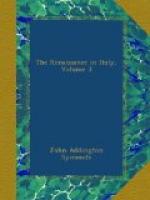Four sculptors, the younger contemporaries of Luca della Robbia, and marked by certain common qualities, demand attention next. All the work of Antonio Rossellino, Matteo Civitali, Mino da Fiesole, and Benedetto da Majano, is distinguished by sweetness, grace, tranquillity, and self-restraint—as though these artists had voluntarily imposed limits on their genius, refusing to trespass beyond a traced circle of religious subjects, or to aim at effects unrealisable by purity of outline, suavity of expression, delicacy of feeling, and urbanity of style. The charm of manner they possess in common, can scarcely he defined except by similes. The innocence of childhood, the melody of a lute or song-bird as distinguished from the music of an orchestra, the rathe tints of early dawn, cheerful light on shallow streams, the serenity of a simple and untainted nature that has never known the world—many such images occur to the mind while thinking of the sculpture of these men. To charge them with insipidity, immaturity, and monotony, would be to mistake the force of genius and skill displayed by them. We should rather assume that they confined themselves to certain types of tranquil beauty, without caring to realise more obviously striking effects, and that this was their way of meeting the requirements of sculpture considered as a Christian art. The melody of their design, meanwhile, is like the purest song-music of Pergolese or Salvator Rosa, unapproachably perfect in simple outline, and inexhaustibly refreshing.
Though it is possible to characterise the style of these sculptors by some common qualities observable in their work, it should rather be the aim of criticism to point out their differences. Antonio Rossellino, for example, might be distinguished by his leaning toward the manner of Ghiberti, whose landscape backgrounds he has adopted in the circular medallions of his monumental sculpture. A fine perception of the poetic capabilities of Christian art is displayed in Rossellino’s idyllic treatment of the Nativity—the adoration of the shepherds, the hush of reverential stillness




